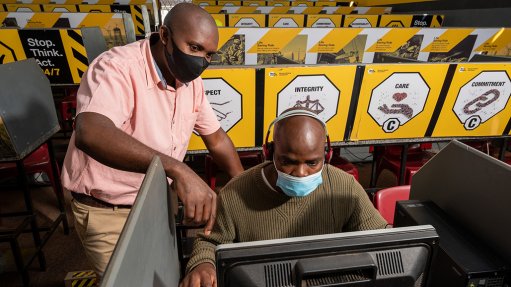
IMMERSIVE LEARNING The training academy incorporates remote e-learning solutions coupled with Dover Assessments for psychomotor skills, 2D & 3D touchscreen, and virtual reality
To underpin evolving digital strategies in a business, training must evolve to cover critical aspects from enhanced safety to productivity in mining, says engineering company Murray & Roberts Cementation education, development and training executive Tony Pretorius.
Murray & Roberts Training Academy (MRTA), just outside Carletonville, has therefore, in the spirit of “vibrant learnership”, introduced multiple methods of advancing through the adoption and use of modern technology, which affords the mining industry an opportunity to develop scarce skills within modern underground mining applications.
MRTA’s “uniquely centralised position” enables a diverse offering of training programmes focusing on, inter alia, shaft sinking, mechanised mining and engineering, conventional mining, as well as a host of safety, health, environmental and quality qualifications.
Boasting a specialised engineering training centre for trackless mining machinery, the centre raises skill levels among operators, servicemen, artisans and apprentices within the hard rock mining industry.
Pretorius enthuses that “several blue chip clients” in the industry have made use of MRTA’s programmes. These clients are largely owners of platinum, gold and copper operations.
MRTA’s programmes, in particular, focus on the mechanised mining space, as well as shaft sinking, engineering, mining services, such as exploration, drilling, arrays and the like.
MRTA offers these programmes by incorporating remote e-learning solutions coupled with Dover Assessments for psychomotor skills, two-dimensional (2D) and three-dimensional (3D) touchscreen, virtual reality (VR), simulator, mass assessment tools, mock-up training, classroom response systems and workplace integrated learning.
This “vibrant learnership”, notes Pretorius, is what sets MRTA apart and makes it unique in training methodologies. MRTA has also incorporated an extended reality framework, which he explains ensures that the training provided “follows a typical situational learnership model”.
Pretorius says coaches – who provide the training – can use interactive touchscreens for 2D or 3D training interventions, which can be deployed with VR training modules, including the use of VR simulators that are developed alongside MRTA’s technology partner, Simulated Training Solutions (STS).
STS was also instrumental in designing and developing the VR Drill Rig Simulator, which Pretorius says is “a first of its kind in the country”, as it is a module that is able to take operators into a fully immersive environment, and teach them the finesse required for rock drilling, for example.
“We’ve been using this simulator for the last three months with huge success,” Pretorius enthuses.
The company’s embrace of digital technologies, he adds, allows the learners to be engaged and to “have fun” even when they are exposed to real-life scenarios, while in a conducive environment where learning can take place.
“It’s really about keeping training exciting to ensure that learners are engaged because that’s when they tend to retain information best,” Pretorius notes.
The course length is dependent on the skills programme and can last from two to three days, or up to 30 days or longer, depending on what occupation-based technical skills are required.
MRTA can currently accommodate up to 450 learners at any given time, and its on-site campus accommodation facilities can house up to 400 of these learners.
At the moment about 280 learners are attending courses at MRTA.
Industry Benchmark
In 2021, MRTA was recognised as a benchmark for training in the industry, and was awarded three golden awards from the Ming Qualifications Authority.
“It was quite a privilege to be recognised as a benchmark, and I think it’s [owing] to the fact that we take training very seriously. We unpack learning exercises to ensure that we use the correct learning methodology and platforms, and we’ve invested significant capital into technology to embrace the Fourth Industrial Revolution,” Pretorius elaborates, adding that the academy is able to “function as a fully digitalised operation”.
In 2021, Pretorius told Mining Weekly that the system at MRTA allows for the seamless creation of detailed digital learner portfolios of evidence – which are then stored in the cloud for retrieval at any stage.
These portfolios are updated regularly through the automatic capturing and collating of assessment results, training time logs and all other details regarding the learners’ training histories. Previously, such portfolios comprised about 120 printed pages per learner.
The paperless system, in addition to being more environment friendly and cost effective, almost entirely eliminates human error from the administrative process, consequently ensuring more accurate assessments, better learner tracking and increased accountability, Pretorius noted.
Safety
Entrenched throughout MRTA’s operations is the company’s firm belief that “everyone has the right to return home to their loved ones after a hard day’s work”, which Pretorius says encourages MRTA to continuously ensure that learners are very well-versed with the safety precautions that need to be applied in the workplace to guarantee their safety at the end of each day.
“We know we’re doing the right things, and that we’re doing the right things, right. We do our best at trying to achieve safety efficiencies, and that’s really the backbone as to why we do what we do here,” he states.
The academy’s new age of training systems is also being rolled out within the projects of Murray & Roberts Cementation itself, thereby further enhancing the company’s reputation for performance excellence and safety.